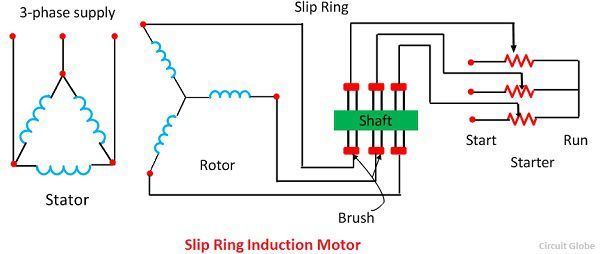Both have 3 a phase stator winding, the squirrel cage has a rotor with bars arranged around it's periphery, these bars are joined at both ends by a continuous ring. This forms a closed circuit of low resistance which is fixed. The wound rotor (slip ring motor) is similar in construction but the bars are replaced by copper windings, similar to those in the stator. They are star connected and the three ends are brought out to slip rings which allow an electrical connection to be made to the outside world.
Jan 13, 2015 COMPARISON BETWEEN SQUIRREL-CAGE AND WOUND-ROTOR INDUCTION MOTORS. The wound-rotor induction motor has the following advantages: • High starting torque and low starting current if the motor is started with the maximum resistance inserted in the rotor circuit.
When no connection is made between these ends and the stator is energised, little current flows in the stator which does not turn, but when some resistance is inserted, current flows in the stator windings and the rotor rotates. As the rotor gains speed the resistance is taken out of circuit and the slip rings shorted together.
The motor runs as a cage induction motor. There is no 'slam dunk' answer for calculating the derating of a motor operated beyond its manufacturer's rated temperature.

There is a very good reason for this. The 'curve' of a motor's performance with regard to temperature isn't linear. In fact, it's far from it. And it will vary a great deal de pending on a number of characteristics associated with a given machine.
These will include its rating at 'ambient' temperature, its size, and number of other things about its shape and mechanical construction. If an individual needs to operate a motor outside the manufacturer's ratings, it's a no-brainer that the manufacturer should be contacted to get information. The hook is economy. A lot of motors can be 'pushed' a bit over their operating temperatures for a short time, but extended operation in the 'red zone' will bring early failure. 'Over-rating' a motor isn't a good idea if the objective is to save a few bucks. It will cost more in the long run to 'cook' the unit and have to replace it than to get one that is rated for the operating conditions or to run cooling to the motor. This is really a question of engineering, and the smart engineer will cool a given motor or will get a different motor that is rated for the operating conditions.
Synchronous and induction machines both produce torque through theinteraction of a rotor magnetic field and a stator magnetic field.The differences between the two types of machines arise because ofthe differences in the way the rotor magnetic field is generated. Synchronous machines have a stati onary (relative tothe rotor) magnetic field on the rotor. Prs serial number dating. This field can be generatedeither by permanent magnets, or by a field winding powered throughslip rings. The interaction of this field with the rotating fieldon the stator creates torque and causes the motor to rotate. Asynchronous motor always rotates at some multiple, determined bythe number of poles, of the line frequency.
If a synchronous motorloses lock with the line frequency, e.g., by torque overload, itwill stall. A synchronous motor cannot start by itself on a fixedfrequency AC source. It either needs to be fed a variable frequencysource, or it needs to be brought up to speed by an auxiliarymotor, sometimes called a pony motor, so that it can generatetorque. Synchronous machines usually require some form of controlto keep the rotor speed locked to the line frequency. Induction machines have a rotating (relative to therotor) magnetic field on the rotor.
In a squirrel cage motor, thisfield is created because the motion of the stator field relative tothe shorted rotor cage induces currents in the rotor. Uchebnik anglijskogo yazika 10 klass starkov ostrovskij perevod. Thesecurrents generate the rotor field, which interacts with the statorfield to create torque. A wound-rotor induction machine has rotorwindings similar to a synchronous machine, in which currents areinduced by the rotating stator field. Induction motors alwaysrotate in some narrow speed range that is less than synchronousspeed.